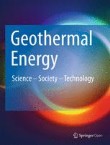Associated Societies
Temperature sensor module for groundwater flow detection around borehole heat exchangers
We present a temperature sensor module (TSM) for detecting the groundwater flow velocity and direction in the vicinity of a borehole heat exchanger (BHE). We demonstrate the method for double U-tube BHEs, whic...
